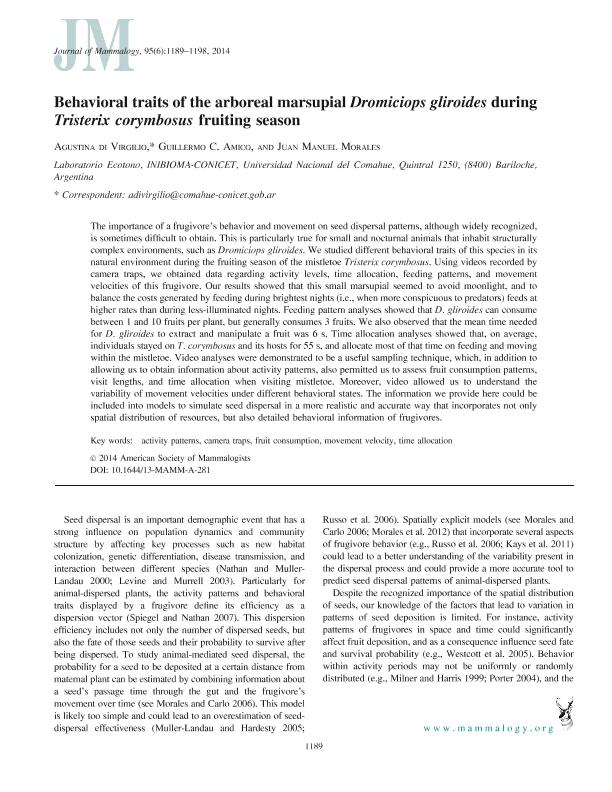Mostrar el registro sencillo del ítem
dc.contributor.author
Di Virgilio, Agustina Soledad

dc.contributor.author
Amico, Guillermo Cesar

dc.contributor.author
Morales, Juan Manuel

dc.date.available
2017-11-06T16:59:14Z
dc.date.issued
2014-12-01
dc.identifier.citation
Di Virgilio, Agustina Soledad; Amico, Guillermo Cesar; Morales, Juan Manuel; Behavioral traits of the arboreal marsupial Dromiciops gliroides during Tristerix corymbosus fruiting season; Alliance Communications Group Division Allen Press; Journal of Mammalogy; 95; 6; 1-12-2014; 1189-1198
dc.identifier.issn
0022-2372
dc.identifier.uri
http://hdl.handle.net/11336/27659
dc.description.abstract
The importance of a frugivore?s behavior and movement on seed dispersal patterns, although widely recognized, is sometimes difficult to obtain. This is particularly true for small and nocturnal animals that inhabit structurally complex environments, such as Dromiciops gliroides. We studied different behavioral traits of this species in its natural environment during the fruiting season of the mistletoe Tristerix corymbosus. Using videos recorded by camera traps, we obtained data regarding activity levels, time allocation, feeding patterns, and movement velocities of this frugivore. Our results showed that this small marsupial seemed to avoid moonlight, and to balance the costs generated by feeding during brightest nights (i.e., when more conspicuous to predators) feeds at higher rates than during less-illuminated nights. Feeding pattern analyses showed that D. gliroides can consume between 1 and 10 fruits per plant, but generally consumes 3 fruits. We also observed that the mean time needed for D. gliroides to extract and manipulate a fruit was 6 s. Time allocation analyses showed that, on average, individuals stayed on T. corymbosus and its hosts for 55 s, and allocate most of that time on feeding and moving within the mistletoe. Video analyses were demonstrated to be a useful sampling technique, which, in addition to allowing us to obtain information about activity patterns, also permitted us to assess fruit consumption patterns, visit lengths, and time allocation when visiting mistletoe. Moreover, video allowed us to understand the variability of movement velocities under different behavioral states. The information we provide here could be included into models to simulate seed dispersal in a more realistic and accurate way that incorporates not only spatial distribution of resources, but also detailed behavioral information of frugivores.
dc.format
application/pdf
dc.language.iso
eng
dc.publisher
Alliance Communications Group Division Allen Press

dc.rights
info:eu-repo/semantics/openAccess
dc.rights.uri
https://creativecommons.org/licenses/by-nc-sa/2.5/ar/
dc.subject
Activity Patterns
dc.subject
Camera Traps
dc.subject
Fruit Consumption
dc.subject.classification
Bioquímica y Biología Molecular

dc.subject.classification
Ciencias Biológicas

dc.subject.classification
CIENCIAS NATURALES Y EXACTAS

dc.title
Behavioral traits of the arboreal marsupial Dromiciops gliroides during Tristerix corymbosus fruiting season
dc.type
info:eu-repo/semantics/article
dc.type
info:ar-repo/semantics/artículo
dc.type
info:eu-repo/semantics/publishedVersion
dc.date.updated
2017-08-09T14:05:00Z
dc.journal.volume
95
dc.journal.number
6
dc.journal.pagination
1189-1198
dc.journal.pais
Estados Unidos

dc.journal.ciudad
Lawrence
dc.description.fil
Fil: Di Virgilio, Agustina Soledad. Universidad Nacional del Comahue. Centro Regional Universitario Bariloche. Laboratorio de Ecotono; Argentina
dc.description.fil
Fil: Amico, Guillermo Cesar. Universidad Nacional del Comahue. Centro Regional Universitario Bariloche. Laboratorio de Ecotono; Argentina
dc.description.fil
Fil: Morales, Juan Manuel. Universidad Nacional del Comahue. Centro Regional Universitario Bariloche. Laboratorio de Ecotono; Argentina
dc.journal.title
Journal of Mammalogy

dc.relation.alternativeid
info:eu-repo/semantics/altIdentifier/url/https://academic.oup.com/jmammal/article/95/6/1189/839390/Behavioral-traits-of-the-arboreal-marsupial
dc.relation.alternativeid
info:eu-repo/semantics/altIdentifier/doi/http://dx.doi.org/10.1644/13-MAMM-A-281
Archivos asociados
